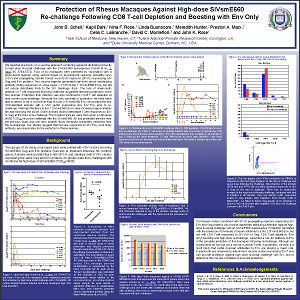Protection of Rhesus Macaques Against High-dose SIVsmE660 Re-challenge Following CD8 T-cell Depletion and Boosting with Env Only
John B. Schell,1 Kapil Bahl,1 Nina F. Rose,1 Linda Buonocore,1 Meredith Hunter,2 Preston A. Marx,2 Celia C. LaBranche,3 David C. Montefiori,3 and John K. Rose1
1Yale School of Medicine, New Haven, CT, 2Tulane National Primate Research Center, Covington, LA, and 3Duke University Medical Center, Durham, NC, USA
SUMMARY
We reported previously on a vaccine approach conferring apparent sterilizing immunity to high-dose mucosal challenge with the SIVsmE660 quasispecies (Schell et al., J. Virol. 85: 5764-5772). Four of six macaques were protected by vaccination with a prime-boost regimen using vectors based on recombinant vesicular stomatitis virus (VSV) and propagating Semliki Forest virus/VSVG replicons (SFVG) expressing SIV Gag and Env proteins. This vaccine regimen generated high-level serum neutralizing antibody (NAb) responses (in some cases > 1:106) to tier 1 SIVsmE660 Envs, but did not induce detectable NAb to the SIV challenge stock. The lack of anamnestic antibody or T cell responses following challenge suggested sterilizing protection of the four animals. Protection from infection was also confirmed by CD8 T cell depletion at nine months post-challenge. Because the only correlate of protection we have been able to detect so far is a low level NAb to a tier 2 SIVsmE660 Env, we boosted the four CD8-depleted animals with a VSV vector expressing only SIV Env prior to re-challenge. Waning NAb titers to tier 1 SIVsmE660 Envs were increased approximately ten-fold following the boost. Some animals lacked detectable T-cell responses to Env or Gag at the time of re-challenge. The boosted animals were then given a high-dose (4000 TCID50) mucosal challenge with the SIVsmE660. All four protected animals from the previous study and one from another study remained completely protected from the re-challenge. Our studies suggest that immune responses to SIV Env, most likely antibody, are responsible for the protection of these animals.
©2012 Yale Department of Pathology. All rights reserved.
Any redistribution or reproduction of part or all of the contents in any form is prohibited. You may not, except with express written permission of the author or the Department of Pathology, distribute or commercially exploit the content, nor may you transmit it or store it in any other website or other form of electronic retrieval system, including use for educational purposes.
